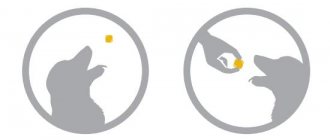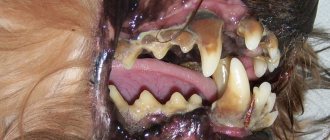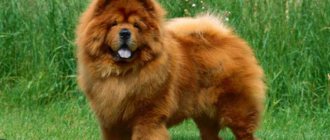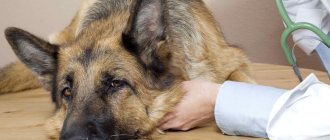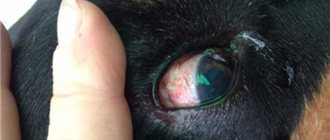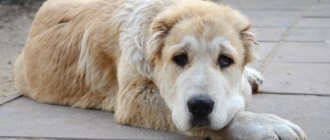Many people don't even think that dogs can be obese. “This is an animal, what are you talking about?” - a common response to the words that the dog is overweight.
Another category of people see that their pet is clearly obese, but they answer: “I like him, he’s such a funny fat guy.”
Neither one nor the other wishes harm to their pet. They simply do not know that obesity worsens the quality of life of a pet, and in serious cases, leads to serious and life-threatening illnesses.
Obesity is a pathological condition that is characterized by excess fat deposits and leads to changes in body functions.
Causes of obesity
There are many reasons why a dog becomes overweight. They may be related:
- with genetic characteristics;
- diseases predisposing to obesity;
- irresponsible attitude of the owner towards his pet.
The most common reasons:
Overfeeding
In each article, we tirelessly repeat how important a correct, high-quality and balanced diet is for a dog, be it dry food or natural food. It is appropriate to add here that feeding should also be moderate.
Some people think that by feeding a bunch of treats to a dog, they are expressing their love for their four-legged friend. But the best manifestation of love is caring for your pet’s health.
Low animal activity
When getting a dog, every person should understand that it is necessary to walk with it. And not 15 minutes a day for her to “do her business” and run home.
The animal needs activity, it needs to be played with, allowed to run and provided with the necessary exercise.
It is very important to understand that any dog needs a certain amount of exercise and activity, regardless of breed.
Of course, you don't need to run around with a Chihuahua as much as you would with a German Shepherd, but none of them should lie around the house all day.
Drugs
The use of certain medications can lead to excess weight gain.
These drugs include antiepileptic drugs and glucocorticoid drugs. In this case, it is called Iatrogenic obesity.
Metabolic disease
Metabolic pathologies can be acquired (due to some disease), or they can be genetically determined.
The genetic factor is that the mechanism of regulation between energy intake and expenditure in dogs is adapted to “wild” conditions. And at home, when food is abundant and living conditions are very limited, the genes regulating this mechanism practically stop working.
The exact reasons for this are poorly understood, but it may explain the predisposition of certain breeds to obesity.
Stress
Yes, not only people “eat stress.” Animals can also have this tendency. One of the reasons why a dog may experience stress is having a second pet.
Or rather, feeding two or more dogs together. Especially if one of the dogs shows clear leadership, and the other is in constant tension because of this. In such cases, it is necessary to feed them separately.
In any situation involving stress in a dog, the owner plays a key role. If you treat your pet attentively and feed him according to the norm, without giving in to his cute “begging” face, then everything will be fine.
Remember that most often dogs have no sense of proportion.
Predisposition
So, which dogs are most likely to be overweight?
Breed predisposition.
The root cause of this predisposition varies among different breeds. For example, some small dogs tend to overeat due to excess energy (a little controversial, but true), and large breed dogs are more likely to gain weight due to osteoarticular diseases. Dog breeds predisposed to obesity (from small breeds to large ones):
- Cairn Terrier;
- Dachshund;
- Cavalier King Charles Spaniel;
- Scottish Terrier;
- Beagle;
- Cocker Spaniel;
- Basset Hound;
- Collie;
- Golden Retriever;
- Labrador Retriever;
- Rottweiler;
- Bernese Mountain Dog;
- Newfoundland;
- Saint Bernard
Among these breeds, Labradors are definitely the favorite in terms of their tendency to be overweight.
Age
The tendency to become overweight in dogs increases with age (by the way, not only the pet itself, but also its owner). On average, dogs are diagnosed with obesity between the ages of 5 and 8 years.
Castration
There are statistics according to which the incidence of obesity in neutered dogs is twice as high as in non-neutered ones. This is especially true for castrated females.
But nevertheless, there is no direct effect of sex hormones on metabolism. They either influence body weight through the nervous system or indirectly alter cellular metabolism.
The issue is controversial, but it is absolutely established that sufficient physical activity after castration prevents weight gain.
Obesity in animals is a multifactorial and polyetiological disease, which is accompanied by the accumulation of excess adipose tissue in the body. The pathology is often found among domestic non-productive animals: dogs, cats.
Obesity is defined as exceeding normal body weight by more than 20% of the physiological norm. Among domestic animals, obesity is registered in more than 30-40% of dogs and cats.
Etiology of obesity
There are nutritional, hypothalamic-pituitary and secondary symptomatic obesity with hypogonadism, hypercortisolism, hypothyroidism, insulinoma. The most common type of obesity is nutritional. It consists of prolonged overfeeding, often in combination with a genetic predisposition to this disorder. As a rule, nutritional obesity occurs due to uncontrolled heavy consumption of starch- and protein-rich foods under conditions of physical inactivity (lack of movement and physical activity).
The widespread introduction of dry diets for dogs and cats has led to the constant presence of food in a bowl and multiple feedings throughout the day, which, combined with physical inactivity, leads to weight gain and the development of obesity. Secondary symptomatic endocrine obesity is caused by such etiological factors as hypogonadism (a disease in which the production of male sex hormones - androgens is reduced.), hypercortisolism (long-term chronic exposure to the body of excess amounts of adrenal hormones, regardless of the reason that caused the increase in the amount of these hormones in the blood.), hypothyroidism (a condition caused by a long-term, persistent lack of thyroid hormones, the opposite of thyrotoxicosis.).
Also, the etiological obesity includes castration of males and females. A contributing etiological factor to the development of obesity in all cases is physical inactivity, insufficient walks or their absence for pets.
Pathogenesis of obesity
The main pathogenetic factor in the development of constitutional-nutritional obesity is an energy imbalance, a discrepancy between the amount of energy supplied by food and its expenditure in the body.
Obesity symptoms
Obesity is characterized by a change in the physiological shape of the animal's body, smooth contours, ribs cannot be felt, and an enlarged abdomen; moderate depression, decreased response to external stimuli, decreased sexual activity, slowed motor functions. With hypothalamic, pituitary-adrenal obesity, a predominant deposition of adipose tissue in the subcutaneous layer of the abdomen, shoulder girdle, sacrolumbar region, and thighs is noted. The skin is hyperpigmented, hair falls out in places. Symptoms of cardiopulmonary failure may occur due to organ overload, as well as obesity of the pericardial sac. In obesity associated with dysfunction of the pancreas, thyroid, and gonads, the leading symptoms are caused by damage to the corresponding organs. Since frequent complications of obesity are atherosclerosis, myocardial dystrophy, diabetes mellitus, fatty liver, cholelithiasis, and reproductive dysfunction, additional signs corresponding to these diseases appear.
Diagnosis
Clinical signs. Laboratory tests in case of nutritional obesity in the blood serum reveal an increase in total lipids, triglycerides, phospholipids, and in case of liver damage - total protein.
Treatment
So, we have determined that the patient is overweight. The first and very common problem that the doctor encounters is that the owners do not see the problem; they often view excess body weight as a sign of good health, and decreased activity as a manifestation of a calm and affectionate character. Changing these beliefs is the first step towards weight loss.
Of course, both owners and doctors would like to have magic pills in their arsenal, by prescribing which we would immediately get a beautiful, slender dog or cat. But so far such effective and safe pills have not yet been invented, and the main method of combating obesity is a dietary approach. In this case, the success of treatment depends on the diligence of the owner. Moreover, all family members should follow the program to rid the animal of excess weight. The owner must understand that losing weight is a complex (emotionally and physiologically) and slow process, and one must be determined and persistent in order to achieve results.
Prescribing a diet implies a change in diet. Even a low-calorie diet should be balanced. When reducing the amount of fat in the diet, it is necessary to ensure that the content of essential amino acids remains normal. It is necessary to maintain lean muscle mass of the body: the animal should lose fat, not muscle. Accordingly, the food must contain a sufficient amount of protein. The food should be tasty. As a rule, feeds are used that are rich in protein and fiber, but poor in starch.
Basic principles of a weight loss program:
1. Body weight loss should occur gradually, from 1 to 3% of total body weight per week. This helps minimize muscle loss and the risk of liver dysfunction.
2. Accurate dosing of feed! The prescribed amount of food must be accurately weighed, and not measured by eye or with a glass (in the latter case, the error may be about 20%). Dogs are fed once or twice a day (in this case, the daily portion is divided into two), the bowl of food is placed for 15 minutes and then removed until the next feeding. A cat may have food left all day, but it is important to follow the daily intake! Not more! If the cat eats all the food at one time, then you can divide the feed into several meals, adding more food little by little throughout the day.
3. Dry food is given to cats in such a way that they eat it as slowly as possible: increasing the feeding frequency, feeding from a narrow container, from where the food must be removed with the paw, or pouring the food into special toys.
4. Combining dry food and canned food can be useful, as it combines the advantages of dry food and canned food: a fairly large volume, ease of measuring quantities, and the possibility of increasing feeding time.
5. Increase activity whenever possible. With dogs - longer walks, more active walks, games, if there are no contraindications to increased physical activity. Cats need to be played at home; they have an innate need to hunt, which does not disappear even in adulthood in cats that are too well fed. Safety toys, mechanical mice, a laser pointer, and small dry food dispensers (toys from which food can be extracted) will help you increase your cat's activity.
6. In addition to food, it is necessary to take into account all the treats that the animal receives during the day. To imagine how much additional (“unaccounted for”) food your pet receives during the day with treats, you can conduct an experiment: when giving a treat to a dog or cat, put the same amount of treat in a jar, evaluate the result in 2-3 days.
"Diet from the manufacturer"
Purina Veterinary Diets OM Obesity Canine / Feline Formula is a therapeutic dietary food for reducing excess weight through low-calorie nutrition.
Hill's Prescription Diet™ Canine/Feline r/d™
Specially formulated for weight management in dogs and cats.
Key benefits:
1. Reducing calories promotes weight loss.
2. Added L-carnitine and lysine help burn fat and strengthen muscles.
The high fiber content ensures a feeling of fullness and reduces “begging” between feedings.
Hill's Prescription Diet™ Metabolic
Key benefits:
1. Weight loss without restrictions for the animal - 81% of cats lost weight in 2 months at home, 89% of cats successfully completed the weight loss program.
2. After weight loss, it is necessary to adjust the feeding rate to maintain ideal weight.
3. Clinically proven to help prevent weight gain after completing a weight loss program.
Eukanuba Restricted Calorie for obese dogs and cats
Indications:
1. Obesity and overweight
2. Obesity and diabetes
3. Problems with joints and their mobility, for which weight loss is relevant
4. Hip dysplasia
5. Osteoarthritis
Eukanuba Weight/Diabetic Control for dogs for diabetic weight control
Indications:
1. Diabetes
2. Persistent hyperglycemia
3. Obesity/overweight in dogs
4. Problems in older dogs (overweight, impaired glucose metabolism)
In addition to “diet” foods, there is a wide range of everyday foods that help reduce and maintain the animal’s normal weight.
Monitor your pet's weight, its health really depends on it.
Types of obesity
There are mainly three types of obesity:
- Nutritional – directly related to overeating.
- Endocrine obesity is associated with certain diseases, such as diabetes mellitus or hyperadrenocorticism. This is actually a difficult question, everything here is confusing. Just as diabetes can provoke obesity, and vice versa, excess weight provokes diabetes and other endocrine disorders.
- Iatrogenic obesity is a consequence of taking certain medications that either affect metabolism or increase appetite.
Symptoms and degrees of obesity
To determine the degree of obesity, you need to know how the quality (index) of the body (somatic status) is generally assessed.
Numbers are used for this. Thus, if an animal has normal weight, then fat mass makes up 13% of the entire body. An obese dog is 40% overweight, while a wasted dog is 20% below optimal body weight.
There are several types of body weight assessment:
- 3 degrees: 1 - below normal, 2 - normal, 3 - above normal. A very vague assessment, uninformative, so it is practically not used.
- 5 degrees: 1 - exhaustion, 2 - below normal, 3 - normal, 4 - above normal, 5 - obesity. In practice, this scale is most often used.
- 9 degrees: from 1 to 4 = from emaciated to below normal, 5 - normal, from 6 to 9 = from above normal to obese.
To more accurately understand the condition of the dog, intermediate indices are used.
On a five-step scale, grade 4 means the dog's body weight is 20% higher than normal, and grade 4.5 means 30% higher than normal.
To make it easier to understand, use the table:
| Degree | External changes |
| Exhaustion - body weight below optimal by more than 20%. |
|
| Below normal - body weight is 10-20% below optimal. |
|
| Optimal body weight. |
|
| Above normal - 10-20% excess weight. |
|
| Obesity - 40% excess weight. |
|
Symptoms of obesity:
- Fat deposits (their degree and location are presented in the table).
- The last two ribs are not visible during movement (normally their outlines should be visible, since they do not connect to the sternum).
- Heavy breathing even after light exertion.
- Change in gait.
- The paws visually appear shorter.
- Arching in the back (not natural).
How to find out the optimal weight of a dog
It is almost impossible to find out the optimal weight of a dog; each organism is unique. Even in breed standards there is a difference of several kilograms. There are several ways that will help you find out what shape your pet is in and whether it needs to lose weight or, on the contrary, gain weight. All manipulations are carried out only by visual inspection and palpation. They do not take much time and do not require special skills.
- When examining the dog from above, the waist should be clearly visible . Part of the chest and ribs are normally separated from the thigh by a narrower area of the body. If there is no “waist”, it’s time to go on a diet.
- All bones of the spine and ribs should be clearly palpable during palpation . Ideally, the last two unconnected ribs are visible when moving, and in some breeds all rib plates are visible. During the cold season, the absence of visual signs of bones is normal. In hot weather, there should be less subcutaneous fat.
- The presence of a “duck” gait is also a sign of excess weight . The dog's movements should be light and free. When a pet begins to waddle when walking, this is a clear sign of obesity.
- If minor physical activity causes shortness of breath, the pet refuses to go for a walk or prefers to walk lying down in the shade. There is no doubt - the dog is definitely overweight.
Consequences
Diseases of the musculoskeletal system . Any of the pathologies of the musculoskeletal system can overtake an obese dog, mainly due to excess stress on the joints.
It is especially worth noting similar pathologies in young dogs of large breeds. The fact is that overfeeding puppies that are in the growth phase entails the development of various orthopedic diseases, including worsening hip dysplasia (especially common in German shepherds). The effects of excess weight can appear in dogs as early as the first year of life.
Pathology of the cardiovascular and respiratory systems . Obesity is accompanied by hypertension, tachycardia and general disturbances in the functioning of the heart, and as a result of breathing.
Diabetes . Obesity causes significant changes in glucose metabolism and insulin secretion (formation). Moreover, the absorption of glucose and the secretion of insulin worsens the more the body weight increases.
Hyperlipidemia and dyslipidemia . Simply put, a disorder of fat metabolism, including obesity, provokes fatty degeneration of the liver.
Urinary incontinence and urolithiasis . There was also an increase in kidney mass in overweight dogs.
Thyroid dysfunction.
Why does a dog get fat?
The reason for an increase in the size of a pet can be either banal gluttony or a serious illness. Therefore, before arranging fasting days and loading with physical exercises, it is better to consult a veterinarian and get tested. After all, diseases of the thyroid gland, adrenal glands, gastrointestinal tract, and hormonal imbalances may not be a consequence of obesity, but its root cause.
The main causes of obesity in dogs:
Reason 1 – overfeeding
The owner cannot refuse the lovely beggar; guests and family members also take part in the performance of “treating the hungry.” Regular extra portions quickly turn into extra pounds.
Reason 2 – unbalanced diet, lack of feeding regimen
The dog is fed foods that are not suitable for the breed characteristics (for example, if a pug prone to obesity is fed with high-calorie food, we will very quickly get a “bun”). This also includes feeding on cheap ready-made food that contains a minimum of animal proteins and a maximum of ballast additives.
Reason 3 – low dog activity
Often, when getting dogs of working or hunting breeds, owners are guided only by external attractiveness. Without receiving the exercise programmed by the breed, such animals are doomed to become bored and fat.
Reason 4 – age-related changes
Aging, the body of any living creature changes not for the better, it becomes decrepit.
With age, obesity can also appear. Photo: Scott Garner
Life processes slow down and a less calorie diet is required.
Reason 5 – genetic predisposition
There are many breeds that are prone to obesity. In addition, if the dog’s ancestors were “in the body”, there is a high probability of being overweight.
Reason 6 – stress
It happens that a new addition to the family (a new pet, a child), a change of place of residence or owner affects the health of the animal in the form of obesity.
Reason 7 – illness
- helminth infestation (helminthiasis) - toxins from the vital activity of helminths can provoke a slowdown in metabolism in the dog’s body
- slow metabolism
- hormonal imbalance (leads to a slowdown in fat breakdown)
- disruption of the thyroid gland, tumor development
Reason 8 – pregnancy
Bitches in an interesting position are usually carefully fed. Without knowing the measures, you can significantly harm her health.
Treatment
To cure obesity in a dog, you don’t need to discover America. The process is simple, but it requires a lot of effort and time from the owner.
If the owner approaches this issue responsibly, you will soon notice progress.
Recipe for losing excess weight:
- Adjust nutrition.
- Add active physical activity.
However, not everything is as simple as it might seem at first glance.
Firstly, you must first find out the reason for gaining excess weight. Secondly, assess the consequences.
Often it is no longer possible to manage with a simple diet. If there is a possibility that functional changes have occurred in the body (and there is always such a possibility), drug treatment may be required.
Important! Before taking any action, you need to take your pet to a veterinarian for examination.
Diet is an integral step to getting rid of obesity. However, you need to approach this step wisely. You cannot simply deprive your dog of food indefinitely.
You can't let your dog go hungry!
If you feed your dog dry food, then you need to switch to another food from the medicinal line. There are special dietary ready-made foods. They retain the required amount of macro- and microelements, vitamins, and at the same time reduce calorie content.
If you feed your pet natural food, everything is a little more complicated. You will definitely have to change your dog's diet.
Ideally, you should seek help from a veterinarian who will create a diet specifically for your pet.
In this case, the diet is compiled taking into account the characteristics of the dog and based on your capabilities (from those products that you are ready to feed your pet). You can request this service in person. if possible, find a specialist online (only you must be sure that this is a specialist in front of you!).
With any type of feeding, when you put your pet on a diet, discipline is very important.
It is your discipline. You must understand that the dogs' health depends on you, so you need to strictly monitor portion sizes.
Features of diet and food selection
The diet does not imply strict restrictions on the animal’s diet. It represents a more balanced diet. It is forbidden to let your pet go hungry or keep it only on water. His food should not be meager. It is necessary to choose the right, healthy food. Fasting will provoke a decrease in blood glucose levels and stomach ulcers. The problems will only increase.
It is recommended to switch to a complete grain-free food. Many well-known manufacturers produce special lines specifically for dogs suffering from excess weight. You can also find food for animals prone to obesity. They will be an excellent prevention of weight gain.
These foods differ in composition. They are dominated by fiber, vitamin complexes and useful minerals. And it contains less fat and carbohydrates than standard food.
Some people prefer natural ingredients as dog food. But you cannot treat her with food from the common table. Spices, fried, marinated foods, etc. will only aggravate the problem. To restore your pet’s shape, he needs foods with sufficient vitamins, fiber, and protein. It is recommended to exclude pork, potatoes, cheese, any sausages, lamb and fatty fish from the diet.
You can feed your pet chicken, only without the skin, as well as wild poultry and beef. The diet should be rich in vegetables; egg whites, oatmeal, cottage cheese and offal are allowed.
If a dog is accustomed to begging its owners for goodies from their table, then the temptation to treat the pet can be very great. Therefore, when eating, it is recommended not to allow the animal into the kitchen, so as not to tempt it and yourself.
Exercise stress
You don’t need to give it a marathon as soon as you realize that your dog needs to lose weight. The dog should not lose weight too quickly. Start with longer walks so that your dog spends more time outside and moving. Then gradually give her more load.
Difficulties may arise in cases where the dog has already experienced disorders in the musculoskeletal system due to excess weight. Then naturally, the animal will refuse unnecessary movements. A veterinarian will help solve this problem, but your pet will need additional care, and you may have to take it for special procedures.
Relieving a pet of excess weight is entirely the responsibility of the owners.
Prevention
Remember one golden rule - rather than treating a disease, it is better to prevent it!
To prevent your pet from becoming obese, you need to follow some rules from the very beginning of his puppyhood:
- Take a responsible approach to feeding your dog, be it dry food or natural food. The diet should be balanced, and the portion should not exceed your pet’s norm.
- If you are not ready for long walks every day, it is better not to get a dog at all.
- You need to monitor your pet’s health and maintain its immunity at a high level. This requires annual vaccination and periodic treatments against internal and external parasites.
German Shepherd puppy weight
The approximate weight of a German Shepherd puppy at birth is about 350-500 g . Let's consider how this discrepancy of 150 g can be explained:
- Firstly, a lot depends on the gender of the puppy, since female shepherds almost always weigh less than boys. And in adulthood, the overwhelming majority of females are smaller and lighter than males;
- Secondly, heredity is of great importance. With a high degree of probability we can say that large puppies are born to large parents. Parents with small dimensions also have puppies that are usually small;
- Thirdly, it is also important how many puppies are in the litter. If there are three or four babies, then their weight can be about half a kilogram, but if there are 7-8 of them, then they will be born quite small and light, their weight can even be a little less than 300 g (by the way, a female German Shepherd can bear and 10-12 cubs);
- Fourthly, the health and age of the mother dog is important. In sick, too young or very elderly pets, puppies are often born weak and lightweight. Naturally, the condition of the puppies itself is also important. So, in one litter there can be strong, strong puppies weighing 500 grams or so, and slender babies that weigh a couple of hundred grams less.
To find out more precisely how the weight of a German Shepherd puppy changes by month, this table will help:
| Puppy age (in months) | Approximate puppy weight (in kg) |
| 1 | 2,5-4 |
| 2 | 5-9 |
| 3 | 9-14 |
| 4 | 13-18 |
| 5 | 14-21 |
| 6 | 15-23 |
| 7 | 16-24 |
| 8 | 17-25 |
| 9 | 18-26 |
| 10 | 19-28 |
| 11 | 20-30 |
| 12 | 21-32 |
Food for obese dogs
Industrial food for obese dogs is specially formulated in such a way that it maintains the required level of nutrients and vitamins, but at the same time reduces the calorie content.
Dietary food lines are available from various manufacturers.
The most popular of them:
- Royal Canin.
- Pro Plan.
- Hill's.
These manufacturers have a wide selection of feeds. Even diet food for obese dogs comes in a wide range: from food for small breeds to diets for large breed dogs.
However, just starting to pour new food into the bowl is not enough. It is necessary to carry out calculations and calculate the daily serving size specifically for your pet, taking into account current and desired weight, body fat percentage and the required rate of loss.
Weight of adult German Shepherds
By the end of the first year of life, the body weight of German Shepherds varies from 20 to 30 kg. But this weight is not final, since Germans gain their maximum weight by 2.5-3 years. Remaining like well-fed butts until 4-5 months, animals of this breed look outwardly mature at 9-10 months, but it is by their 3rd birthday that they are truly strong and strong with the dog’s maximally developed muscle mass.
According to the Breed Standard, the weight of a male German Shepherd ranges from 30-40 kg. The weight of a female German Shepherd is usually less: from 22 to 32 kg (during pregnancy, the dog’s weight becomes higher for obvious reasons). The weight of older German Shepherds may be slightly higher or slightly lower than that of individuals in their prime.
There is no need to worry if the animal weighs a little less or a little more than the mentioned indicators (for example, an adult male may well weigh 29 or 41 kg). But if the difference from recognized standards is significant, then this is a reason to think: is everything normal with the pet’s health?
Briefly about the main thing
- Obesity is a pathological condition, in other words, a disease that leads to serious disorders in the body and shortens the life of a pet.
- Causes of obesity: overfeeding the dog, endocrine diseases, and taking certain medications.
- Some dog breeds and older individuals are at risk.
- Obesity in dogs leads to many diseases that can affect all systems of the body: pathologies of the musculoskeletal system, disorders of the heart, difficulty breathing, endocrine diseases.
- In addition to obvious external signs of excess weight, with obesity, changes in the behavior and general condition of the dog are observed: passivity, shortness of breath, strange gait.
- Before starting treatment, an examination by a veterinarian is required to determine the stage and consequences of excess weight.
- The dog must lose weight gradually, so you need to approach diet and exercise wisely.
Weight loss rate
Weight loss should be gradual. Sudden weight loss is unacceptable. This can cause a deficiency of important substances in the body. When returning to a standard diet, there is a high risk that the dog will quickly gain excess fat again.
Weight loss should last several months, and in a week the pet should lose a maximum of 800 grams. This will allow it to quickly return to its previous shape, without causing harm to the body.
Obesity is a serious problem that cannot be ignored. Even a slight weight gain can negatively affect your pet's condition and lead to complications and health problems in the future. Therefore, you need to carefully monitor your dog’s build. Proper, balanced nutrition and sufficient physical activity will protect your pet from weight problems.

